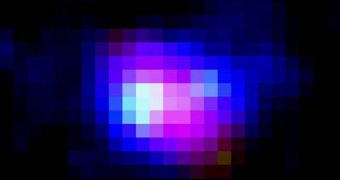A newly found gas blob, discovered at the very start of the Universe, has recently been identified as being at least ten times more massive than the second largest class of such objects, known as Lyman-Alpha blobs. The new formation has been discovered more than 12.9 billion light-years away, which means that it was formed less than a billion years after the Big Bang. Other discovered blobs were only formed two to three billion years after the Universe exploded into existence, which means that, other than being significantly larger, the new object is also at least twice as old as any other one.
“I have never heard about any objects that could be resolved at this distance. It's kind of record-breaking,” Carnegie Institution researcher Masami Ouchi, whose team has named the new blob Himiko, after an ancient Japanese goddess, said. The expert added that the enormous gas cloud was formed when the Universe was roughly 800 million years old, some 400 million years after the appearance of the first stars, and way before the first galaxies started differentiating.
To put things into perspective, Himiko is a gas cloud that is about half the size of the Milky Way, which is considered to be a large galaxy. It holds the same mass as 40 billions of our Suns, and measures some 55,000 light-years across. While their sizes would easily make someone think that these types of blobs simply spring in front of astronomers when they use telescopes, the reality is, unfortunately, different. On account of the perturbations and observation errors that occur, both orbit- and Earth-based observatories have a hard time peering back into the distant past, when the Universe was in its early days.
Ouchi also shared that the blob might represent a number of things. One theory holds that it's nothing but the gas halo of a (very) supermassive black hole, while another states that it could represent the first stage in the forming of a very large galaxy. “Even for astronomers, we don't understand. We are keen to try to understand what those systems are in the reionization epoch,” the scientist added for Space. The Reionization Epoch spans at the beginning of the Universe, from 200 million years after the Big Bang, to approximately one billion years. During this time, the first stars appeared, and galaxies finally began to differentiate from their gas clouds. And one theory holds that black holes appeared sometime after stars, and before galaxies.
At this point, the researchers are enlisting the help of an army of observers, including the W.M. Keck Observatory in Hawaii, which can detect if stars are forming in the blob, the Chandra X-Ray Telescope, which is able to test the black-hole scenario, and even the Hubble Space Telescope, which will take near-ultraviolet pictures of the formation. The most popular orbital telescope cannot use its optical camera to view objects so far back in time, on account of the interferences that are in the way.

 14 DAY TRIAL //
14 DAY TRIAL //